Glossary of Places - P to Z
A - B | C - F | G - O | P - ZP
Passeggiata
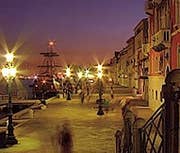
Quay of the Zattere An evening walk in Venice!
The archetypal Venetian passeggiata is the walk on the long quay of the Zattere in Venice Dorsoduro, with a breeze wind or at sunset, far removed from the crowds.
Piano Nobile
In the ancient Venetian residences, it indicated the noble floor; the ground floor was used for stewardship.It is therefore what we call the main floor. Please note, it could be just as well on the first floor as on second, depending on the manner in which the aforementioned residence was built.
Besides, in palaces they often consider the first and the second floor as two piano nobile.
Piazza
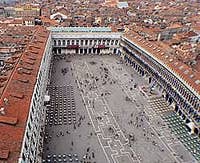
Piazza San Marco We saw it earlier regarding campi; Venice counts only a single Piazza, that of Saint-Mark, which gives way to the “Piazzetta”, itself too small to have the right in the same way of nobility.
Piazzetta is that which follows the Doge's Palace of the Doges until it reaches the bacino San Marco, where, in a more gruesome way, capital executions took place between the two columns.
The Piazza is located in the middle of Procuraties, where the tourists crowd together with the pigeons.
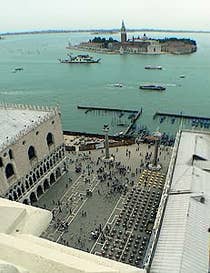
Piazzetta San Marco Venice Finally, to continue making simple there is also an "intermediate" place, the Piazzale (big place or open walkway) name given to Piazzale Roma the place of the (dreadful) bus station at the north entrance of Venice.
Piscina
It was a small expanse of stagnant water that was later filled up with earth, as they did for rio terrà (see below).And the Pasina, what is it? We must be honest, we inquired, but not the single Venetian was able to enlighten us.
Portego
It is the central room of a big residence which often overlooks the apartments.It was an unheated room where visitors of passage or customers were received, a kind of living room of passage.
The portego had few furnishings but it was decorated with weapons, trophies and the portraits of family. They often gathered there for receptions on the occasion of marriages or during the time of great festivals.
R
Ramo
Literally, this is a small branch, one subdivision of a calle. And according to the degree of ramification they speak of primary ramo (ramo primo) or else secondary ramo (ramo secundo).It does not mean that the ramo is narrower than the calle; it can very well have the same breadth. On the contrary rami (in the plural) are often short and are able to even end in dead end.
Back to Top of Page
Remer
It is a carpenter who specializes in the sculpture of Forcole (see in the letter F from our glossary), the wooden pitchfork which allows the holding of one or several oars.Rio
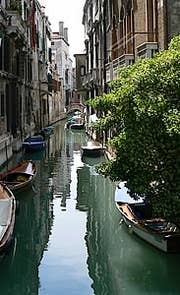
The Charm of Venetian Rii Rii (in the plural) are the small canals, the most numerous, and are permanently crossed by using one of the 420 bridges of Venice (or more … the "experts" argue on the number).
The rio has a bent course most often and it is edged with houses. The term of “Canal” is reserved for the Grand Canal, for the Canal of Cannaregio and for the Canal of Giudecca.
Rio Terrà
Rio terrà, rio terà or else rioterrà, they write as they speak in Venice, are as the name points it out a rio which they filled up with earth and with sand to transform into a calle.Riva
When the fondamenta (walking bank along a rio) is in front of an expanse of broad water, as the bacino di San Marco for instance, he can then become a “riva”.Ruga
It is simply a street; term comes besides from the French word “rue”. Often it is a street enlivened and edged with boutiques (botteghe).S
Salizzada
Salizzada or salizada with an only one z, means “street selciata”: the street laid with cobblestones. These are the first ones calli to have been laid with cobblestones or covered with stones.In this title, so certain salizzade (in the plural) were paved with masegni, typical of Venice, others were covered with bricks laid out in “V” as a succession of fish bones
Sandolo
It is a small flat-bottomed boat.Back to Top of Page
S'ciopon
Sandolo bis, it is a small light boat for waters rather shallow.The s'ciopon holds his name of the gun which they put down on its front (lightly tipped up down) for hunt in the duck in the corners rather shallow of the lagoon it was the small boat of the hunters of the lagoon!
Scuola
A mixed brotherhood often of mutual aid to that can perform civil, religious, public or private functions.Scuole (in the plural) was under the patronage of a saint. There were Scuole of pure devotion but for the most part, they had a corporate function more and mutual for a given social group.
So there was a scuola of zotti, a scuola for the injured war veterans. But in other cases, they could be reserved for national groups, for instance Greeks or else Albanians.
If the Scuole are still present in the Venetian landscape, it is because they competed amongst themselves, from XVth century until the XVIIIth century, to have the nicest buildings, the most beautiful works of art, and the most precious relics!
In brief, they heavily participated in the tremendous development of Venetian art over the same period by nourishing and by paying, often generously, a significant number of Venetian artists who came, partly because of the Scuole, to Venice to exercise their art.
Among the Venetian Scuole, that of San Rocco is still active, the members still meet and they can see them with the hooded clothes with holes for eyes during certain holidays in the Church of Frari… impressive!
Serliane
Or Serliennes in the plural. These are windows composed of a central bay covered with an arch, framed by two more narrow openings covered with a supporting beam. They owe their name to their creator: Sebastiano Serlio (1475-1554).Sestiere
In the plural, sestieri. The sestiere is a district, a section of Venice, such as boroughs of New York City or arrondissements of Paris, for example.The word derives from the figure six, Venice having been cut up in effect in six quarters: Cannaregio, San Polo, Santa Croce, Dorsoduro, San Marco and Castello.
At the origin of cutting up, towards the second part of year 1000, sestieri corresponded to groupings of parishes in six quarters.
Their constitution had been made obligatory by the increase of population which required dividing the city in districts to manage it better.
Beware: the numbers which are seen on houses corresponds to those of the sestiere and the neighboring sestiere can therefore easily have houses with the same numbers, and of course, to make it simple, you can have the same street (calli) names in different sestiere.
It is necessary to know that since 1178, the ducal counselors numbered six, one for each sestiere. It was therefore a division which weighed as much on a democratic level as on the administrative one.
Back to Top of Page
Sottoportego or Sottoportico
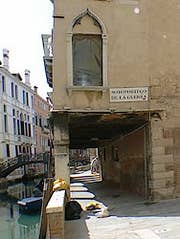
Sottoportego of Guerra It is a porch which passes between houses.
The name in two parts: Sotto Portico, is more explicative, a portico.
But the sottoportego can also be closed only on one of its lateral sides, when it follows a rio for instance and makes it possible link up a calle with a neighboring bridge that passes under the houses which border the bank of the rio.
Squero
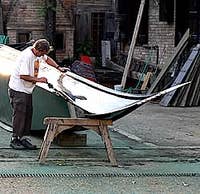
Gondola Squero in Dorsoduro It is a dockyard.
In its current meaning the term refers especially to workshops that manufacture and repair gondolas.
Strada
It is the street, a “broad” street and there is only a single Strada in Venice, Strada Nova in Cannaregio.It has been opened at the end of the XIXth century in this sestiere which was, at that time, quite mazelike; a Venice pastiche of Haussmann in Paris.
T
Terra ferma
It is the… “dry land”! Very easy to understand in comparison with the “wet” Venice land.It was the way the Venetians called it, in opposition to their earth won on the water and for which, one thousand years later, they continue battling to tear it off from swallowing up.
Terrazzi alla Veneziana or Terrazzo
It is a mortar typical of Venice, composed of a mixture of marble remains and stone, used as floor covering.The fragments of marbles are then polished to make them the most bright possible.
It is practically impossible to avoid Terrazzi alla Veneziana in the houses and palaces of Venice.
Topa
Topa literally translates… rat. It is a flat-bottomed, stocky, small boat.Particularly functional and practical to move through the rii of Venice.
Traghetto
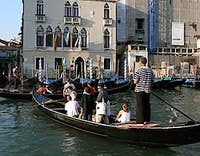
Traghetto in Venice It is a word with dual meanings; either a gondola with two pilots, or a kind of receptacle which allows to cross the Grand Canal while standing!
It is therefore necessary to remain very still so it then became the name of the docks for the aforementioned gondolas.
Vaporetti killed this trade partly by berthing alternately on each bank of the Grand Canal.
Nevertheless, traghetti (in the plural) are still well used daily by the Venetians who work on the other side of the Big Canal, as it really is quicker than vaporetti (plural of vaporetto).
The Traghetto of San Tomà and that of the market of Rialto are the most active, doubled even in the peak times!
Back to Top of Page
V
Valesana
To row “ as the valesana” means to row standing with two crossed oars.Vaporetto
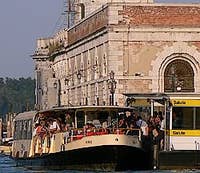
Station of Vaporetto of the Salute It is the Venetian bus, a steam bus that is rather ancient. The poor vaporetti (in the plural) apparently do not have the right to retirement and date back several dozens years on average.
They vibrate, they snore, and they shake and bounce along on these old metallic shells and often made rusty nuts.
But without this vaporetto old, horror for your feet, it makes it good break when they are tired from walking; ascending and descending bridges...
But it is necessary to have the time and not to think like an “impatient American”. At a peak time, with all stopping and by being crammed like sardines (sardea) plan 40 full minutes to go from the dock of Ca' d’Oro to San Zaccaria to San Marco, a whole trip of a little less than 3 kilometers.
But moreover, which pleasure of taking it in the evening a little before midnight. It is holiday aboard. The most part of his passengers go out in effect of table and are joyful or go out of a concert, of party between friends, etc and this chit-chat, the discussions buzzing all over the place in a frankly very nice ambience surrounded assorted groups of romantic couples, delighted families and in elegantly dressed patricians.
Do not to miss because on top of that, the Grand Canal at night, it is superb!
Venetian Blinds
Ah yes, Venetian Blinds were born in Venice, this shutter with fine small strips here which protects you from the sun without keeping you from spying on your neighbor, occupation most valued in Venice where they know everything, where they hear everything, where everybody knows everybody...You can therefore understand their need for anonymity and why carnival and masks were always so popular in Venice.
A - B | C - F | G - O | P - Z
Back to Top of Page

